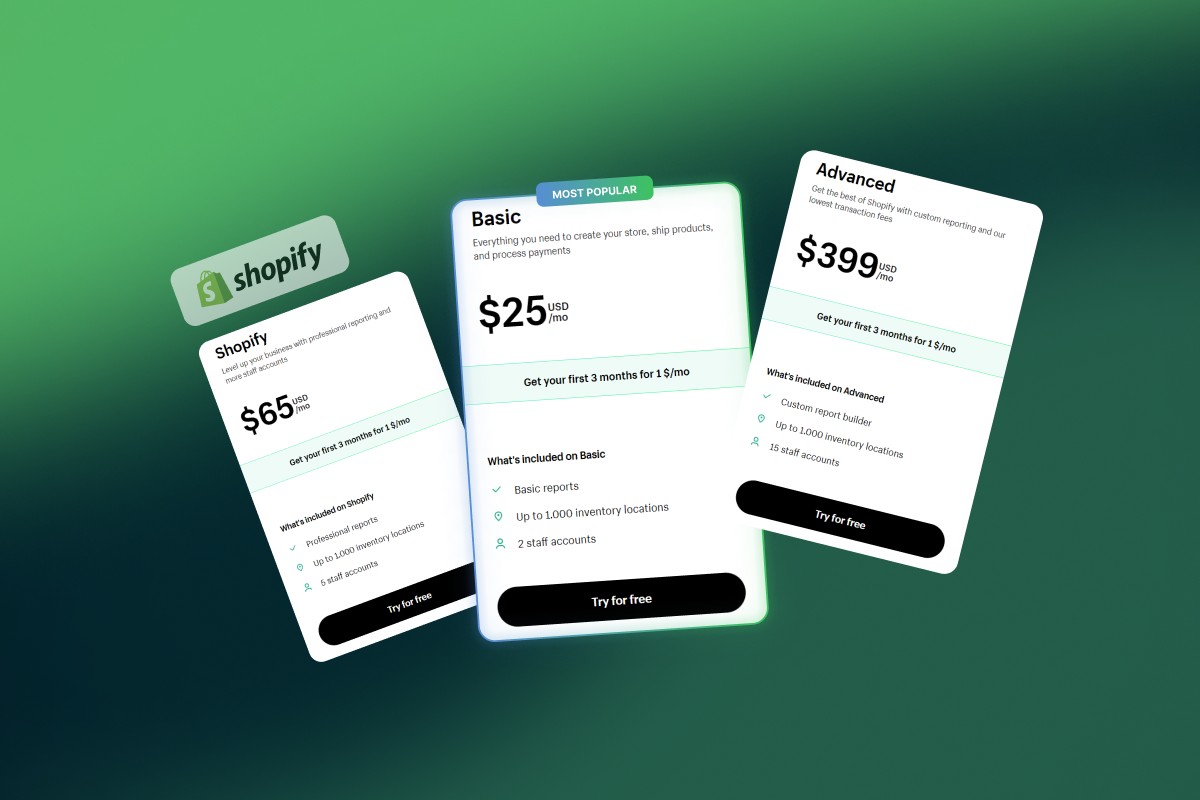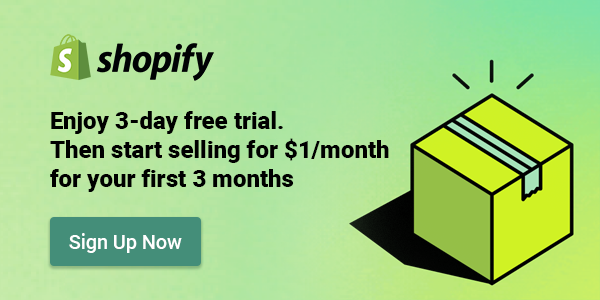Table of Contents
Shopify is a renowned e-commerce platform that has gained immense popularity since its establishment. Over the years, Shopify has experienced remarkable growth and currently holds a significant position in the global market with a 19% market share and a revenue of over $4.6 billion.
What sets Shopify apart is its commitment to understanding and meeting its customers’ requirements. Consequently, the platform offers Shopify pricing plans specifically designed to fulfill the needs of e-commerce business owners.
No doubt, one of the top-of-mind options is the Shopify Basic Plan. In this article, discover how Shopify Basic Plan can be the ultimate game-changer for your e-commerce journey.
Scroll down for more!
| 💡 Recommended reading: |
What is Shopify Basic Plan?
Shopify basic plan is one of the primary pricing options on Shopify. It specifically assists small-scale merchants in establishing their online stores and effectively managing their e-commerce businesses.
With the plan, merchants gain access to a Shopify Store with fundamental e-commerce features. It allows them to sell their products or services online and offline, catering to a small to medium-sized customer base.
Shopify Basic Plan Features
1. Common Features
Shopify plans all have the following features in common. You will gain access to them when choosing the basic plan.
- Unlimited products
- Unlimited bandwidth
- Brand assets
- Fraud analysis
- Manual order creation
- Discount codes
- Abandoned cart recovery
- Analytics
- Finance reports
- Customer support
2. Additional Features
If it is similar to other plans, why should you consider the basic plan of Shopify? The answer lies in some additional features that set the plan apart from the others.
2.1. Online store
The basic or any higher-tier plan enables you to create an online store, personalize its appearance, and effectively administer it through your Shopify account. You can also use a convenient built-in theme editor to customize the visual aesthetics of your store according to your preferences.
Besides, over 90 mobile-responsive themes, including 11 free Shopify Themes available in the Shopify Theme Store, can ease your store design process.
2.2. Blogs
An integrated blogging engine allows you to publish articles that can keep your customers updated regarding events and promotions. You can also engage in valuable interactions by receiving customer comments and feedback.
2.3. Staff
The Basic Shopify plan allows for utilizing two staff accounts in your store, granting them specific permissions required for tasks such as product addition or order management.
2.4. SSL certificates
An SSL certificate is a security measure that establishes a secure connection between a server and a browser, ensuring the protection of your information and your customers’ data.
Shopify offers the capability to enable SSL certificates, which encrypt your online store’s content and enable secure publication using “HTTPS” instead of “HTTP”.
Hence, your online store’s URL in the address bar will display the SSL padlock icon, indicating the implementation of SSL encryption.
2.5. Reports
Monitoring your business performance is made possible through the utilization of reports. The basic plan allows you to access an array of analytical tools, including
- Analytics page
- Financial reports
- Product analytics
- Live View
- Acquisition reports
- Inventory reports
- Behavior reports
- Marketing reports
These comprehensive reports enable you to track and assess various aspects of your business operations effectively.
2.6. International commerce
The plan facilitates the expansion of your business internationally by offering support through Shopify Markets.
This cross-border management tool empowers you to customize and configure specific settings for each international region, facilitating global growth.
Shopify Basic Plan Price Breakdown
1. Monthly Charge
The Shopify basic plan costs $25 per month (pricing may vary across different regions).
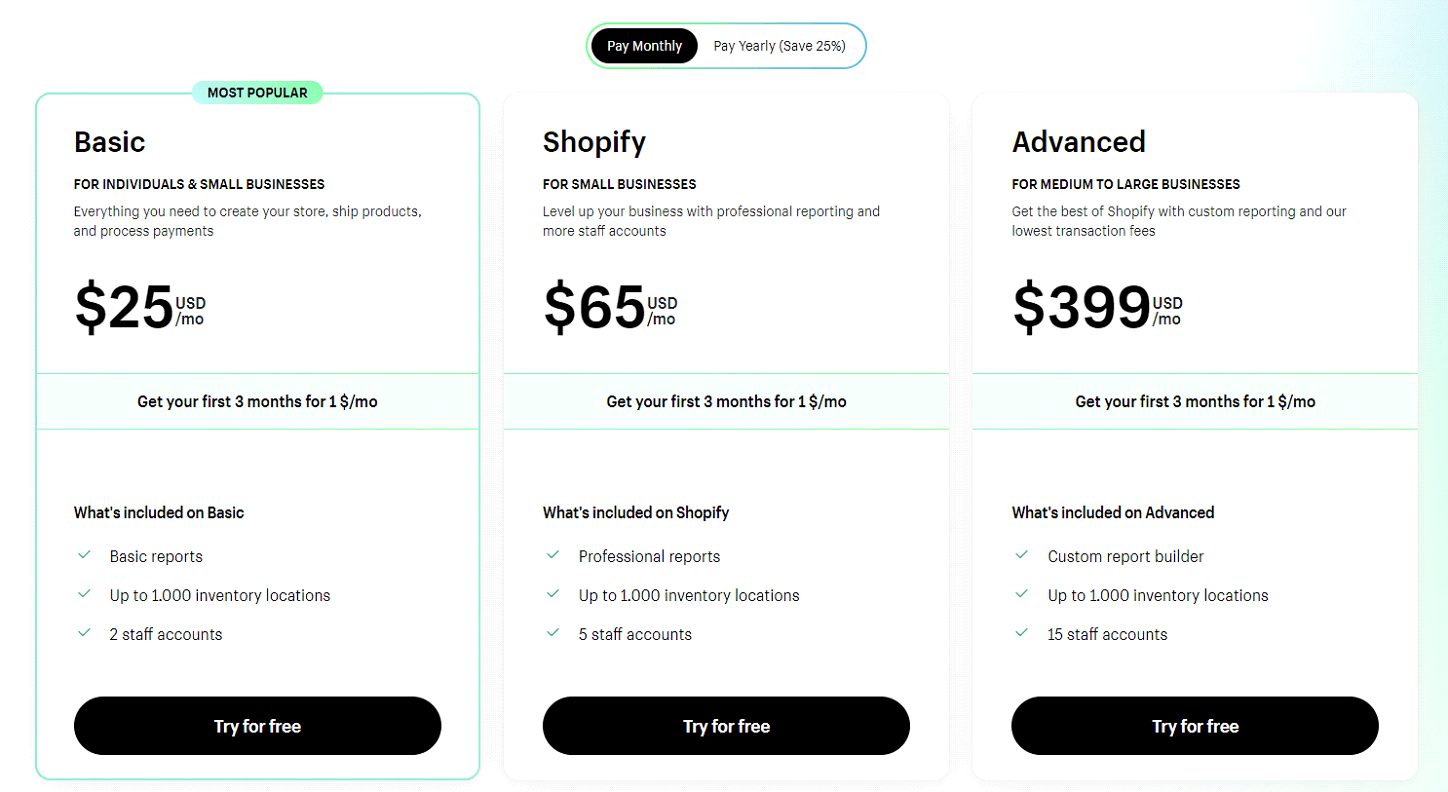
Shopify pricing plans with Shopify Basic Plan, Shopify Plan, and Advanced Plan
Starting in November 2022, Shopify introduced a promotional offer to use the plan for just $1 per month during the first three months of subscription.
2. Transaction Fees
2.1. With Shopify Payments
This chart shows the transaction fee per Shopify Plan.
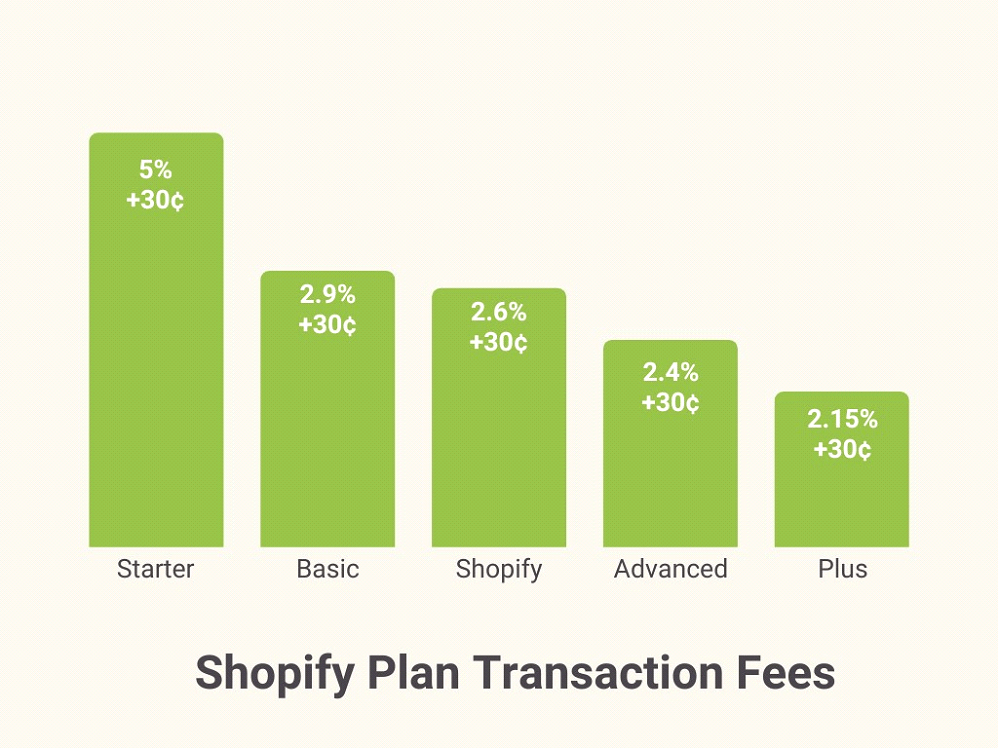
If you use Shopify Payments, you will only pay the credit card rate for each transaction, which is 2.9% + 30¢ USD for the Basic plan.
You will not pay any additional transaction fees to Shopify or to your payment provider. This can save you a lot of money and simplify your accounting.
2.2. Without Shopify Payments
If you use a third-party payment provider, you will pay both the credit card fee and the transaction fee to Shopify.
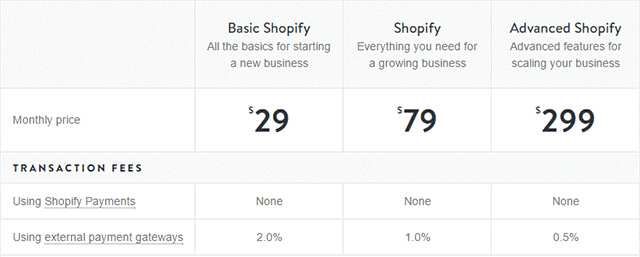
Source: WebsiteBuilderExpert
The credit card fee is the charge that the payment provider itself imposes for processing credit card payments, which varies depending on the provider and the region. You can check Shopify’s Payment gateways list for fees imposed.
The transaction fee imposed by Shopify for integrating with external payment providers is 2% for the Basic plan.
For example, if you use PayPal as a third-party payment provider for your Shopify store based in UAE:
-
-
- Credit card fee: 4.4% + $0.30 USD per transaction for UAE merchants.
- Transaction fee: 2% for the Basic plan.
-
This means you will pay a total of 6.4% + $0.30 USD per transaction.
It is advisable to thoroughly review the Shopify pricing details applicable to that particular country before proceeding.
3. Additional Costs for Shopify Basic Plan
3.1. Domain for your store
Your Shopify store will initially be assigned a domain in the format of “nameofyourstore.myshopify.com,” allowing it to function fully.
Shopify provides domain name registration services, with prices starting at $14 per year. Instead, you can explore other domain name registrars such as Namecheap or GoDaddy.
An important note is that you can retain the flexibility to transfer your domain to another registrar even if you stop using Shopify. For more info, visit Shopify Help Center.
3.2. Email Hosting
In the review of the Shopify Basic Plan (as well as other Shopify Plans), it’s important to note that email hosting is not included. While web hosting is provided in almost every plan, you must install apps to send emails using your store’s domain.
One such app is the Shopify Email app, free for the first 10,000 emails sent. Beyond that limit, there is a charge of $1 for every 1,000 emails sent.
3.3. Shopify apps
The expense associated with Shopify Apps is distinct from the cost of the Shopify Basic Plan. Consequently, it is essential to evaluate the specific requirements of your business to determine which apps you should install.
Based on Shopify’s research, the average merchant typically installs 6 Shopify apps on average, resulting in a subscription cost of approximately $19/month.
3.4. Shopify themes
Shopify Themes are not included in the Shopify Basic Plan or any other Shopify Plan. Nevertheless, a wide array of free and premium themes is accessible within and outside the Shopify platform.
The pricing of Shopify Themes can range from $0 to $350, typically requiring a one-time purchase.
| 💡 Learn more about customizing Shopify themes in our article Custom Shopify Themes: A Comprehensive No-Coding Guide. |
3.5. Shopify POS pricing
To give you an overview of the expenses associated with using Shopify POS for your store, consider the following estimates:
- Shopify POS Lite: On the Shopify Basic Plan, you can utilize Shopify POS Lite at no additional cost. The one-time investment for the Shopify POS system starts from $1,094 per store.
- Shopify POS Pro: $89 per store location. For the first year, the investment for Shopify POS Pro begins at $2,133 per store. From the second year onwards, the cost reduces to $1,068 per store annually.
It is important to note that the initial investment for Shopify POS hardware may vary for each merchant, and the estimated costs provided here represent the minimum spending based on the most affordable hardware options available.
Pros and Cons of the Shopify Basic Plan
Let’s dive deeper into the pros and cons of the Shopify Basic Plan to see whether this pricing tier will be suitable for your business:
1. Pros of Shopify Basic Plan
1.1. Appealing pricing
One advantage of the Shopify Basic Plan is its affordable pricing. Priced at $25 per month (prices may vary by region), the plan offers a cost-effective solution for entrepreneurs and small businesses looking to establish their online presence.
Compared to the higher-tier plans, the plan provides a budget-friendly option without compromising essential e-commerce functionalities.
1.2. Various themes and Custom site builder
One of the most thrilling aspects is the opportunity to choose a theme and fully customize its appearance, ensuring that your store uniquely reflects your products and brand.
Shopify themes serve as templates for your e-commerce website, providing a solid foundation for building your store. Shopify offers 11 free themes to choose from, or you can invest in one of the many premium themes available.
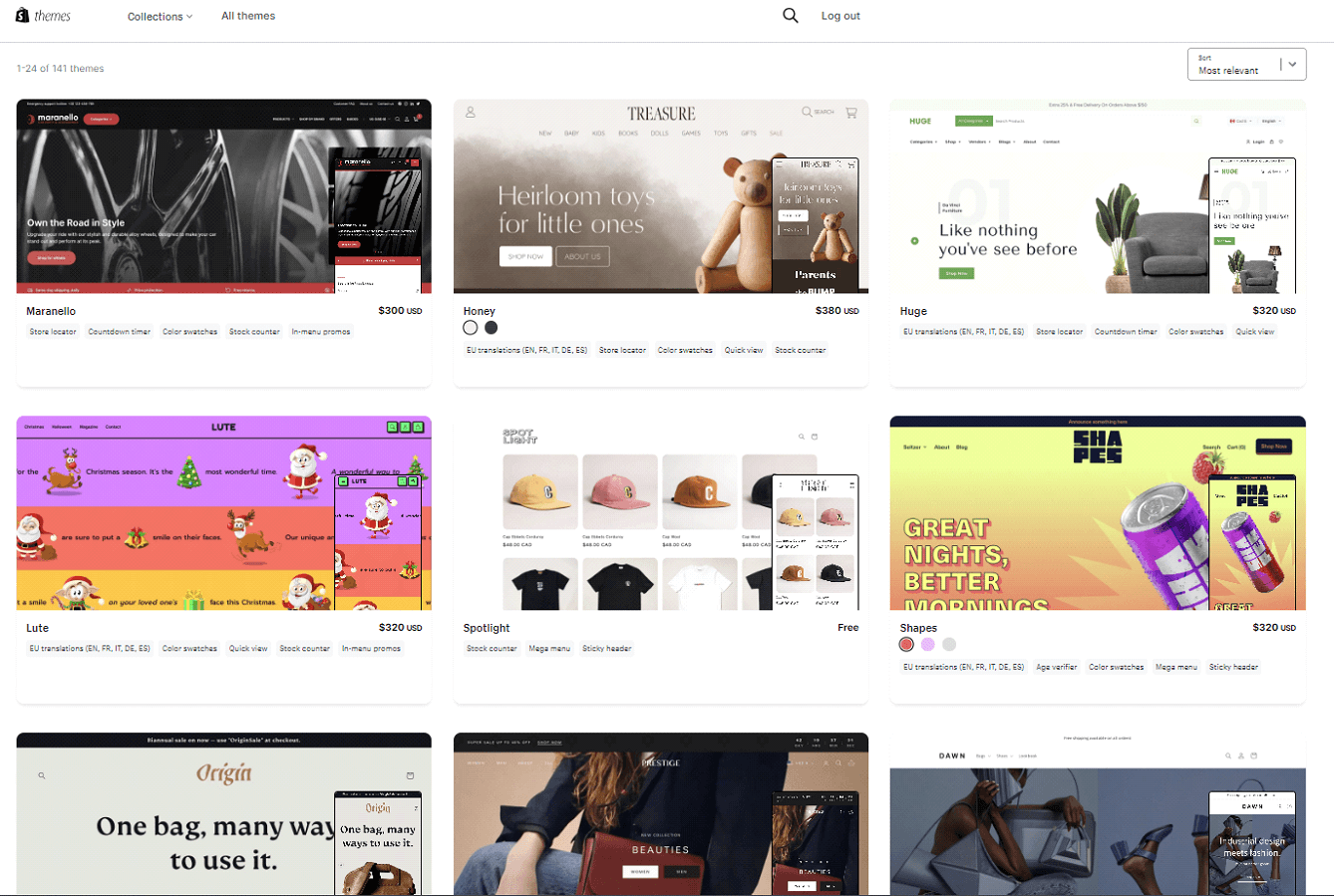
Once you have selected your desired theme, you can use the advanced drag-and-drop editing tool. It is incredibly user-friendly and effortless to use.
Shopify provides a vast library of stunning images you can use for your store. Additionally, you have a wide selection of design elements, fonts, animations, and more at your disposal.
1.3. Unlimited product listing
Even with the Basic plan, Shopify provides the freedom to set up unlimited product listings and sell without constraints
Moreover, Shopify enables you to reach customers worldwide through in-person or online sales. You can have up to 1,000 inventory locations, allowing you to establish warehouses in Warsaw, depots in Durban, stores in Seattle, and more.
If managing inventory differs from your preference, but you still want to sell products, Shopify is optimized for dropshipping and print-on-demand services. It caters to diverse business models, ensuring you can pursue your desired approach.
1.4. Apps Integration
Shopify offers direct integrations with over 8,000 apps on the Shopify App Store that cover a wide range of functionalities, including:
- Social media integration
- Drop shipping and print-on-demand services
- Order and shipping fulfillment management
- Marketing, conversion, and SEO tools
- Store management features such as customer support, chat, loyalty programs, and more
- Additional design features
1.5. Effective checkout system
Shopify’s checkout system is unparalleled in its functionality. It minimizes the need to rely on third-party payment providers by allowing you to accept payments directly on the platform.
One of the standout features is the Shop Pay tool, which offers a speedy checkout experience four times quicker than standard checkout tools. Its “one-tap” nature facilitates swift transaction completion and improves conversions by up to 50%.
Moreover, you can incorporate various elements into your checkout process, including upsells, order bumps, coupons, donations, and more.
You can also enhance the quality of your customer contact lists by collecting additional data, while the editing tool allows you to customize the checkout page to align with your brand.
Lastly, you can incorporate options such as flexible shipping, pre-orders, subscriptions, express checkouts, and more, making Shopify’s checkout system one of the most comprehensive and robust worldwide.
1.6. Automation Tools
Shopify recognizes the importance of incorporating automated technology into its platform. One of the most recent solutions for automation is the release of Shopify Magic, an AI-powered product description generator.
The good news is that you can access these automated features even with Shopify Basic Plan!
With the help of user-friendly, no-code building blocks, you can effortlessly create automated workflows for essential tasks such as inventory management, loyalty programs, order fulfillment, fraud prevention, etc.
2. Cons of Shopify Basic Plan
2.1. Transaction fees for third-party payment gateways
You will incur additional transaction fees using a third-party payment gateway instead of Shopify Payments.
💡 For the Shopify Basic Plan, merchants will be charged a 2.9%+ $0.30 transaction fee for each sale made through third-party payment gateways.
2.2. Limited access to advanced features
The Basic Plan gives you the essential tools to run your online store, but you won’t be able to use some of the more advanced features that Shopify offers.
However, you will still have access to only a few of the features that are only included in the higher-tier plans. For example, you can create gift cards, generate professional reports, recover abandoned carts, or offer real-time carrier shipping.
2.3. Limited staff accounts
The Basic Plan supports only two staff accounts. If you require more staff members to access and manage your store, you need to upgrade to a higher-tier plan.
2.4. No advanced reporting
The Basic Plan provides basic analytics and reporting tools. However, if you require in-depth insights and advanced analytics for your business, you might find the reporting limitations of the Basic Plan restrictive.
2.5. Limited availability of priority support
Priority support is a feature that allows you to get faster and more personalized help from Shopify’s customer support team.
When you contact Shopify’s support, your questions are bumped to the top of the queue and sent to the most suitable Shopify Support Advisor. This way, you can resolve any issues or queries you might have more quickly and efficiently.
Priority support is not included in the Basic Plan because it is a premium feature that is only available to users on higher-tier plans. This means you may have to wait longer for assistance with any technical or account-related issues.
Who Should Use Shopify Basic Plan?
Merchants with moderate sales volume, seeking a cost-effective standalone store that fulfills their requirements.
This option is ideal for those exploring the world of e-commerce, as it offers essential features to various business models.
An important advantage of the Shopify Basic plan is its ability to activate numerous sales channels. So, it enables seamless integration with various social media platforms, other e-commerce platforms, and search engines.
❗ Shopify Basic Plan’s transaction fee of 2.9%+ $0.30 can have a notable impact on your cost structure if your sales volume is substantial. It is advisable to leverage Shopify Payments to avoid credit card processing fees.
FAQs
1. How many stores can you have on Shopify Basic Plan?
You can have one online store. The Basic Plan allows you to set up and manage a single store for your e-commerce business. If you require additional stores, consider upgrading to a higher-tier plan offered by Shopify.
2. Will upgrading or downgrading a Shopify pricing plan lose all the data?
No, regardless of the Shopify Pricing Plan you select, your data will remain accessible at all times. Whether you decide to upgrade or downgrade your plan, the availability of your data remains unaffected.
3. Does the Shopify Basic Plan offer free hosting?
Yes. Except for the Starter plan, Shopify offers secure and limitless e-commerce hosting as part of all its plans. Additionally, you can incorporate e-commerce into an existing website by utilizing the Buy Button.
4. How much does the Shopify Basic Plan charge for the bandwidth?
You will pay no fees for bandwidth on the Shopify basic plan. All Shopify pricing plans, such as Shopify Plus and Starter, offer unlimited bandwidth for free.
5. Is Shopify Basic Plan worth it?
The walkthrough of the Shopify Basic Plan above may help you gain insights into the plan’s pricing, features, pros and cons, etc.
There is no doubt why the plan gains an upsurge in popularity among online merchants. It offers a wide range of essential tools and supporting features to start and manage an online store.
However, the plan choice depends on your store’s expectations and situations. It implies room for customization. If the basic plan can offer, it will be an ideal choice. Otherwise, consider other options in the Shopify pricing plans.
The questions below can ease your decision-making process.
- Do you need two or fewer staff accounts?
- Are four inventory locations enough?
- Can you go without professional and advanced reporting?
- Can you get by without showing actual calculated shipping rates at the checkout?
If the answers are yes to all the questions, you should choose the Shopify basic plan.
Final Words
Shopify Basic Plan will be ideal for those who want to start or manage their online store with moderate sales volume and less than two staff for operation. You will have access to many crucial features within a friendly budget.
The basic plan offers two main factors, affordability and helpful functionality, to help online merchants establish and operate their online stores easily. It explains why the plan is the preference of many Shopify online store owners.
So, having insights into your business plays an important role in deciding on a Shopify plan. The platform is well-known for various packages that can adapt to different requirements and customization.
If you like this article, stay tuned with OneCommerce Blog for more Shopify insights, tips, and tricks!
